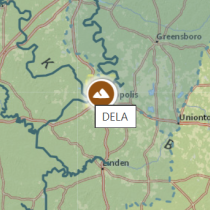Construction Contractor Earns National Award for NEON flux tower
July 25, 2016
Milender White Construction Co., a NEON contractor earned a National Excellence in Construction Eagle Award from the Associated Builders and Contractors (ABC) earlier this year for constructing a NEON tower. ABC is a national construction industry trade association representing nearly 21,000 chapter members. The award was for constructing the NEON flux tower at relocatable terrestrial field site, Lenoir Landing in The Ozarks Complex (D08).
“Associated Builders and Contractors is honored to recognize Milender White Construction Co. with a well-deserved Excellence in Construction Eagle Award for their commitment to high quality construction, innovation and safety in their work on the Lenoir Landing Tower,” said 2016 ABC National Chair David Chapin, president of Willmar Electric Service, Lincoln, Nebraska.
A challenging construction project
Lenoir Landing is located in southwest Alabama along the Tombigbee River, approximately 80 miles north of Mobile. The tower construction was completed in June 2015 and is located in a bottomland hardwood forest. During construction, workers had to contend with significant rainfall that flooded lower areas of the site several times.
Flooding of LENO during construction
The 149 ft NEON tower required four guy wires secured to anchors in the ground. For two of those anchors, Milender White Construction Co. used an alternate system, called a helical anchor, that consisted of a 64 ft long corkscrew-like extendable deep foundation anchor. This anchor system both protected the wetland environment and enabled the crew to finish construction as scheduled.
Leno Tower
“Milender White Construction Co. staff, along with NEON site Supervisor Ron Blattner, were both resourceful and paid very close attention to details, helping make this project a success,” said Jeff Coleman, NEON Director of Facilities and Civil Construction. Jeff also notes that this site won the award for the largest number of reptiles, including snakes and alligators, using the boardwalk during construction.
Data availability for Lenoir Landing
Earlier this year, a dozen flux tower data products for Lenoir Landing went online. You can explore and download these free data from the NEON data portal.
